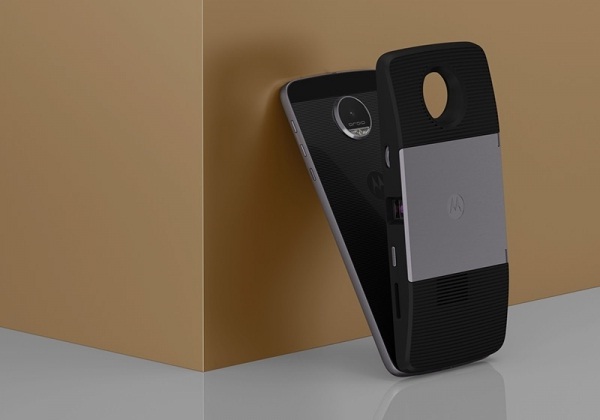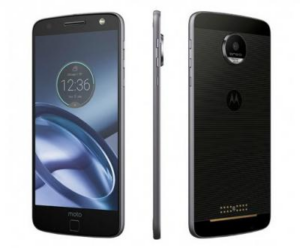Google’s Project Ara was a unique concept when it was first introduced, back in 2014: a modular smartphone, which users could modify to suit their tastes. The battery, camera and even display could all be switched out.
While Ara hasn’t arrived yet (although we hear it’s getting close: Project Ara is Coming This Year), other companies have been looking at the modular phone space with a slightly different take. LG’s G5 (and ‘Friends’) could arguably be placed in the category. However, it is Lenovo – under the Motorola brand – which has launched the newest challenger.
The Moto Z smartphone, set to be launched this summer, uses a set of components called Moto Mods. Like the Ara concept, these are attached using magnets, and add or enhance functionality. For example, owners could add better speakers, or a pico projector.
Each Mod is attached to the rear of the phone. The standard unit features a 5.5″ AMOLED display (2560 x 1440), with a Snapdragon 820 processor, 32GB/64GB of storage and 4GB of RAM. Without Mods, the chassis is 5.2mm thick – partly due to the lack of a headphone jack. Users must use the USB-C connection (plus included adaptor) or Bluetooth, instead. A 13MP camera, fingerprint scanner and 2,600mAh battery are also integrated.
An upgraded model is found in the Moto Z Force, which has a shatterproof display, larger (3,500mAh) battery and 21MP camera. This model is thicker, at 7mm.
It is not the small size of the phone which makes it interesting, though – it is the Mods. One, the Style Shell (an aesthetic accessory), will be supplied with the handset. Other Mods must be purchased separately. They will include a JBL speaker (the SoundBoost), which adds two 3W drivers and an additional 1,000mAh battery capacity; the Power Pack (extra 2,200mAh battery) and Insta-Share (a pico projector that can throw a 70″ image at 854 x 480).
 The Insta Share Mod adds a DLP projector to the phoneThe Insta-Share Mod’s projector is an LED DLP unit with a 100,000 hour lifetime. The Mod itself features a kickstand and weighs 120g; it is 11mm deep. Brightness is about 50 lumens, with a 400:1 contrast ratio and 1.2:1 throw ratio. -40° to 40° keystone correction is built in, as is a 1,100mAh battery; this provides about an hour of power. The Mod is charged via USB-C.
The Insta Share Mod adds a DLP projector to the phoneThe Insta-Share Mod’s projector is an LED DLP unit with a 100,000 hour lifetime. The Mod itself features a kickstand and weighs 120g; it is 11mm deep. Brightness is about 50 lumens, with a 400:1 contrast ratio and 1.2:1 throw ratio. -40° to 40° keystone correction is built in, as is a 1,100mAh battery; this provides about an hour of power. The Mod is charged via USB-C.
A concept unit called OneCompute was also being shown. This is a combination of a Mod, attached to the phone’s back like any other, and a wireless dock. The dock can connect to an external display via HDMI, which will then mirror the smartphone’s screen. Additional ports (HDMI and three USB at the time of writing) are also built in to the dock section. Lenovo claims that latency is low.
After being attached, Mods communicate with the phone through a set of pin connectors. For instance, the charge level of battery mods can be monitored. Mods are hot-swappable.
Lenovo has said that it will maintain the size and shape of the Moto Z for at least two generations, to ensure backwards compatibility with future Mods.

